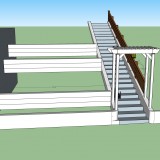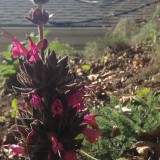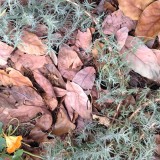
One of the many tracing paper overlays that I used to think through the placement of the plants
Okay, I’m back to the series which never ends after a break for flipper fence building, Thanksgiving and a few days nursing a cold.
“Constructing a meadow community” translating from Planting in a Post-Wild World, means choosing a bunch of shortish plants which work well together, with an emphasis on grasses. (Well, maybe a little more than that.)
I’ll get into the details of the community building, but I’ll say first that I’m not so sure about all of my decisions, but they’re done.
In the world of the DIYer, there’s a big gap between the idea, and what actually gets executed. Then again, that is true for most art. I spent a lot of hours researching plants, trying to find plants which would work together as a community, had low water needs and which would provide nearly continuous bloom over the course of the year. It’s a puzzle that runs in four dimensions, the fourth dimension being time.
Then, of course, I had to find the plants themselves, and that was not so easy. So my original selections were edited to fit what I could actually find in stock at our local nurseries. (Most of the plants came from the wonderful Theodore Payne Foundation Nursery.)
I’ve been doing this long enough to pretty much expect a certain percentage of these plants will not do well…you know, just ’cause. And then I also expect that once stuff comes in and starts to come together, I’ll have to make changes or fill gaps. Editing comes with the territory.
If I’d had more lead time, I wold have grown more stuff from seeds and cuttings–so I’d have had more options and saved a lot of money. Isn’t that always the case? You pay for speed and convenience. I know this. But I really wanted the plants to have a chance to root down a little before our torrential El Niño rains hit in January. At least our money is going to a worthy non-profit.
So, that’s the end of my excuse-making and complaining.
Lets look at a what a meadow community consists of:
First, there are layers.
As I mentioned my previous posts, Planting authors Rainer and West encourage us to plant densely, but intelligently. The plants are not crowded, but no space is wasted–as it is in nature. As simpleton humans, the best way to approximate the abundant intelligence of natural systems is by developing our own mimetic systems. In Planting, Rainer and West encourage us to conceptualize our planting in consecutive layers:
The structural layer: In a grassland, this includes tall grasses and species with tall flowers which will poke up above the rest, preferably too, these flowers will form interesting dried seed heads or pods for continuing visual interest. Think milkweed, for instance. These should make up 10- 15% of your community.
The seasonal theme layer: These are plants chosen to add seasonal interest either through bloom or texture. So for instance you might choose certain plants for their spectacular spring bloom, knowing they will act more like green companions to the other plants for the rest of the year. Ideally you can mix this category up enough so that you have continual interest in the garden. Think irises, for instance. These make up 25-40% of your community.
The ground cover layer: These plants are more functional than showy–shade tolerant plants like low grasses and creeping ground cover which will suppress weeds and help anchor the soil. Rainer and West admit that this is often the most difficult category for folks to fill, because nurseries sell flashy plants, not sturdy background players. Think sedges. These make up about 50% of your community.
The dynamic filler layer: These are short lived, opportunistic species which will self seed and pop up whenever there is a temporary space to exploit. Think about wildflowers, for instance, which show up first in the spring, and fade away as the perennials come back to their own. These make up 5 -10% of the community.
Now, this sounds pretty straightforward, but once you get into the weeds (so to speak) it gets a little confusing. I wasn’t always able to decide what category a plant should be in.
For instance, yarrow (Achillea millefolium) is a seasonal theme layer plant, but it is low and spreading and works rather well as a ground cover when not blooming. It’s usually considered a sun-loving plant, but our sun here is not like normal sun, it’s SoCal SunPlus! ™ and the slope gets a lot of it, so I don’t think the yarrow would mind if it got some shade from tall grasses and the like. Basically, since I like yarrow, and already had it growing on the slope, I just doubled down and planted a lot of it, making it sort of do double duty as both theme layer and ground cover. All of this is to say, I fudged through the categories. If the garden is a design disaster, it’s not Rainer and West’s fault.
My ratios don’t line up exactly with theirs, but they are not crazy far off. I found it was hard, as they said, to find much choice of ground cover plants–especially in the drought tolerant category. I know I don’t have enough. I think if I were smart now I might start some interesting grasses from seeds to fill the inevitable holes which will form as some of my selections die.
Planning for seasonal interest and function
My primary goal for this mini-meadow was to provide food and habitat for insects and other small critters. My secondary goal is for it to be an attractive front yard landscape. Both of these criteria hinge on the plant choices being sufficiently dynamic to keep the yard interesting for both people and critters.
Rainer and West– as well as others– have warned me that one of the dangers of meadow gardens is that they can be really boring looking if they are too grass-heavy or otherwise poorly planned. Instead of ending up with a fabulous Piet Oudolf-esque landscape, your “meadow” looks like an overgrown lawn. Aesthetics aside, we also want flowers in continual bloom to feed the critters, so planning is critical. (Other meadow design dangers, according to Rainer and West, are towering plants–remember the intimidation factor I spoke about before?–and clashing plant color or textures. Meadow are diverse, but mysteriously unified.)
I started keeping notes on the plants I liked with all their basic stats, including their bloom time. The notes got so out of control that I was forced to make a spreadsheet. Now, some people really like themselves a spreadsheet, but I am not one of them. The fact I was forced to make one only shows how much information there is to juggle in this process. In fact, I began to wish I knew more about spreadsheets, because more functionality would have helped at times–like, being able to arrange the list by bloom time or color or whatnot. But I was content enough just to have it all in one place in standardized columns.

Anyway, for the seasonal interest plants, I was keeping my eye out for any native plant which had strong insect or bird appeal, and which was relatively small. My slope is not big, so if I wanted a diversity of species and the ability to have bloom over multiple seasons, the plants couldn’t be too large. Otherwise I could just plant six big shrubs and call it done. My sweet spot for this seasonal category was around 1 foot high (the flower stalks may be taller) and anywhere from 6 inches to 2 feet wide. This led me to some plants I’ve never grown before, including:
- Sisyrinchium bellum (Blue eyed grass) This is an pretty little grass-like plant with tiny blue flowers, very meadowy. Pro: it’s a self seeder! Con: It’s summer dormant, meaning it will leave holes in my landscape in the dreary height of our long summer.
- Monardella villosa ‘Russian River’ (Coyote mint) This one is new to me, a small leaved creeping plant with purple blooms the insects just love. The foliage is also gently mint scented. I planted this along the terrace edges so it can spill over and hide our ugly retaining walls. I also planted it closer to where people walk, so we can smell it.
- Eriophyllum confertiflorum (Golden yarrow) This is a small shrub, not a true yarrow at all, with “ladylike” habits and proportions. It blooms more in the summer, so is valuable, as so many plants want to do all their business in the spring.
- Sidalcea hickmanii “Cuesta Pass” (Checkerbloom): This is a cute little miniature mallow. I bought it on a whim because it is so very endangered. It’s called Cuesta Pass because it only grows in the Cuesta Pass anymore (and at the Theodore Payne nursery). Unsurprisingly, it strikes me as fussy. Fingers crossed it will like our slope.
- Linnum lewsie (Blue flax): This is another excellent meadow-y meadow plant, made to peek up between the grasses.
The problem with unfamiliar plants is that they are unfamiliar. It’s nice to know the ways of a plant when you choose to use it in a landscape. Many of my selections are complete mysteries to me. That can be fun. I’m really curious to see how they’ll grow in and what they’ll do. It’s also a little nerve wracking.
In this seasonal interest category, beside the plants already listed, and the yarrow which I mentioned above, I’ve also got a good deal of Salvia spatheca (Hummingbird sage) planted, and a few other things that I can’t remember right now.
My goal was year round blooming. I don’t think I quite have that ( the November–February period is drab, even here), and what I do have is not equal. Spring is glorious. It’s easy. That’s when everything seems to want to bloom, and all the foliage is lush. That’s when we take pictures of the yard, so we look like we know what we’re doing.
Some plants will bloom intermittently though the spring and summer and into the fall, dragging out the show, but I’m just going to have to see how much of that happens. There are far fewer late summer bloomers to choose from. I’ve planted native goldenrod (Solidago californica) even though it can be an rangy, weedy terror, simply because butterflies love it and it blooms when everything else is dead. If it takes over the slope, I’ll have to come up with a plan B. I’ve also got a few Zauschnerias (California fuschia) in place for later summer into winter bloom, and am really hoping that wild sunflowers will show up give the slope some fall color and happy chaos.
On Grasses:
As I said above, I need more, I suspect. Instead of being too heavy on the grasses, my meadow might be too…random. Too insufficiently grassy to be meadowlike. The world of grasses is confusing, especially as regards dormancy. Some sleep in the winter, some in the summer. Okay, but how bad will they look while dormant? Will they vanish or just look pleasantly dry? Some avoid dormancy if you give them water. Some die if you give them water at the wrong time. Oy! Save me from our crazy native grasses.
Right now I have three species of native bunching grasses on the slope.
The first is Sporobolus airoides (Alkali dropseed). This is the tallest of my grasses. It gets to be three feet tall, with more height from the seed heads, I believe. It’s showy, with nice airy seed heads. I planted it in the “back” portions of the slope, i.e. the furthest from the street and stairs. (As one of my aunts once said of gardening, “I finally have gardening figured out: tall stuff goes in back!”) This way it doesn’t block other plants, and it will be pretty when backlit by afternoon sun. It also serves to hide the retaining walls and other ugly bits of infrastructure. It falls under the structural category because it is striking, more of a diva than a backgrounder.
The second is Aristida purpurea (Purple Three Awn). This is also a lovely grass, just not as tall as the Sporobolus. I used a lot of it –it’s one of the backbones of the slope, so I hope it’s happy and looks right. By the way, it’s not a purple grass–the purple in the name refers to the purplish cast of its seed heads. As far as categories go, I sorta decided in my fudging way that it must be a seasonal theme plant, mostly because it ain’t groundcover and it ain’t a structural plant. Probably.
The third is Festuca idahoensis ‘Warren Peak’ Idaho fescue. This is a small fescue which is drought tolerant, which I am using in the groundcover role. It’s okay in that role, but I need more groundcover which spreads on its own. This fescue sits in polite clumps, waiting to be divided. But you know, they had lots of it at the nursery, and it will fill up some space with short grassy goodness. Good enough!
In general, I need more ground cover. One idea I have is that I have some wild strawberry growing in the shade under the pomegranate at the top of the slope. It’s beginning to take off after a slow start. I’m going to root some of it and introduce it on the slope, where I think it will be okay in the shade of taller plants.
What I don’t know about:
Community. I understand how to make the plant groupings work aesthetically–in theory, at least– but I’m not enough of a botanist to understand their more hidden interactions and relationships to one another and the soil and the world at large. Natural plant communities are extraordinarily complex. Communities designed by master designer/botanists are pretty complex. My community is…well, a little random. What do I know about what plants want or need, much less how they interact with each other? But I do have faith that the plants will tell me what they want–if I listen closely. This means that some of my ideas will be jettisoned (plants will die) and some unexpected things will probably happen, and I’m ready to go with all of that. I’m just waiting for my orders.






What about water? Did you add drip or will these become established and then need no water?
Ah, water is a whole thing which I should probably cover in depth. But at the moment I’m hand watering them.
There’s a yellow peanut flowing plant that starts to flower this time of year ( December) that might be interesting. I think it also adds nitrogen to the ground.
watch out for the purple three awn. It self seeds everywhere. It also can get caught on clothes and fur very easily. I am constantly pulling out volunteers otherwise it would be all pta
Really? I have some in the back and haven’t seen any self seeding — I’d welcome it there! 😉 In the front, no one will brush it going down the stairs so there should be no seed-in-clothes issues. But self seeding out front? Hmmm. Could get interesting. Mostly I’m open to seeing what happens.
It’s awesome that you’re doing this, and thanks so much for sharing the very hard work and awkward guesswork that goes on behind the scenes.
My experience with permaculture has been similar: when I first encountered the idea of plant communities, it made me realized that I just didn’t know nearly enough detailed plant species information to take even a first step! It took me about 4 years of intensive gardening and learning before I felt ready to take a PDC and proceed with any confidence at all, but now there is still lots of learning in order to put theory into practice. Every climate and micro-climate is unique, our gardening priorities vary, our desire to mimic and incorporate our native plants can really make things more complicated. And, as you say, it can be hard to find plants and seeds to begin too!
I think all of this continues to show us how detached we really are from our landscapes, their functions, and how we can interact with them in healthy ways. The knowledge gaps for those of us who aren’t Native Americans/First Nations are massive (and it can be for those folks as well, depending on circumstances); we are walking a new path into being. But this is the challenge and opportunity of climate change/peak oil adaptation–deepening our understanding of the ecosystems we inhabit and taking small, incremental steps into the new world taking shape before our eyes.
It will be wonderful to see how your slope evolves over time as your knowledge deepens; thank you so much for sharing the journey!
Thanks, Toni! We do have so far to go, to reconnect. “We are walking a new path into being.” : I really like that!!!!
Hi, I am really enjoying reading about your process and progress. One plant that came to mind for ground cover is thyme, masses of different varieties, seeds itself about, super easy to propagate, bees love it and it is perfect for hot dry areas.Also there is a procumbant rosemary which would look lovely tumbling over an edge. Leptinella sp.,acaena sp. and Pratia angulata also would work well in that situation. You mentioned a linum (flax), did you know that the seeds that are sold for consumption will also grow into beautiful graceful and delicate 2 ft plants that have the most stunning blue flowers, these would be a real cheap gap filler, just chuck a handful in, anytime of year and they pop up and are in flower in about a month.
Looking forward to seeing the pics of it all planted up.
Thanks for the ideas! Are you from New Zealand by chance?
Thyme is a really interesting idea. I’d been working only with CA natives, but thyme would blend well with them, visually, and yes, it is perfect in form and function. It might be a little delicate for the company. I know–it’s known as tough, but our natives are tougher still. I might try one or two in the gaps and see how they do. I’m not a purist about the natives, it’s just that our climate is so extreme that it puts even Mediterranean plants to the test.
The flax is a native flax–I don’t know how “seedy” it will be. I’d love it if it would self-seed. I’ve grown regular flax in our back yard, amongst more tender plants getting regular water, and it was delightful! A really fun plant, as you say.
I love me a spreadsheet, here. I can even make them sort. But I do understand that other people hate them…
…I’m Mediterranean in climate, so not a total match, I agree about the thyme, and also creeping rosemary–very much like the upright kind in terms of wants and needs, but lays flat-ish and waterfalls out of containers/down walls
Rosemary is fantastic, one of my favorite plants. We grow a lot of it around here (it’s probably in 50% of LA landscapes, I kid you not), and it’s in our yard already–in the back. Actually, the trailing form used to be on the front slope, too But it doesn’t match the whole meadow vibe.
To be “able to arrange the list by bloom time or color or whatnot”, just assign each category a number in a separate column and sort by that (time can be months 1 – 12, colors can be number or letters), then sort.
Have you thought about California Buckwheats for year round color/texture? When the flowers are done blooming they turn a gorgeous dark magenta. Theodore Payne has a great selection of them. I just planted some of the Russian River coyote mint and it’s already doing great. Seems like a super vigorous species! Really enjoying this series, btw.
I am enjoying your series about putting into practice the ideas presented in “Planting in a Post-Wild World”. I have been doing much the same for some time, and it is an ongoing experiment. I am also a landscape designer trying to utilize these ideas in my clients’ landscapes – but there is so little understanding of, and much resistance to, anything that is too out of the ordinary, it is an uphill struggle.
Anyway, mostly I wanted to comment that there’s really no need to stress about whether you are creating the right communities. It’s been well-established in ecological research that plant communities form as much by chance as by anything else. The plants that get there first – by roots left after a fire, by water, by wind, carried by birds or animals – begin a community and those that thrive and fill the available niches best, survive. Plant communities alter through time, impacted by weather, age, etc. So really, if you select plants which have a good chance of thriving in your place, your ‘random’ community has just as good a chance of becoming a true plant community as any other.
Thank you so much, Signe–that’s a wise attitude.
And also, good luck with your clients. I’m fascinated with how this is all playing out–we need to make this shift, but there are such entrenched forces working against change. You’re truly on the front lines, and I wish you the best.